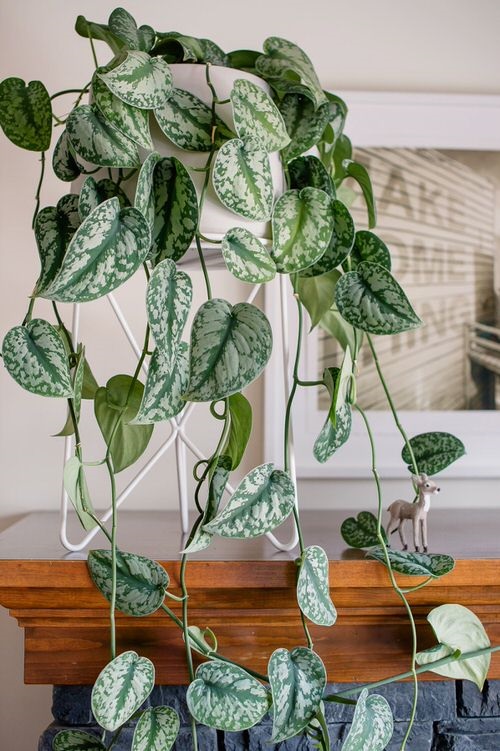Do you want a houseplant that is stunning and easy to care for? Learn all about How to Grow Satin Pothos now!

Find out How to Grow Satin Pothos from our article if you want a houseplant with bright, showy foliage and trailing stems. Add it to your beautiful plant collection!
Have a look at the best types of pothos here
Satin Pothos Plant Information
Satin pothos is similar to its cousin plant Epipremnum aureum, and is one of the easiest houseplants to care for. Noted for their glossy foliage, variegated with silvery-grey splashes, the vines can grow up to 4-10 feet under favorable conditions.
You can train the plant beautifully on walls, stakes, railings, or in hanging baskets.
Best Types of Satin Pothos

- Scindapsus pictus ‘Silvery Ann’: Silvery Ann(e) is a gorgeous variety with highly variegated, light-green heart-shaped leaves.
- Scindapsus pictus ‘Argyraeus’: This variety has fewer splashes with more defined and uniformly dispersed silver markings.
- Scindapsus pictus ‘Exotica’: You can choose to grow this cultivar that has dark green, larger, lance-shaped leaves with bigger silver splashes.
Here’s how to get bigger leaves on any pothos
Choosing the Right Container for Satin Pothos
An 8-10 inches pot will be ideal for growing Satin Pothos. You can go for clay pots, beautiful ceramics, or hanging baskets to complement its gorgeous foliage.
Repot the plant every 2-3 years when you see the roots growing out of the drainage holes. Choose a pot 1-2 inches bigger than the existing one with a good-quality indoor potting mix.
Find out how to grow pothos here
Propagating Satin Pothos
Propagating Satin Pothos is quite straightforward. Snip 6-8 inches cutting from a healthy vine, remove the bottom leaves, and plant it in a well-draining medium. Place it in indirect sunlight and keep the medium moist. You’ll notice new growth in 2-4 weeks.
Requirements for Growing Satin Pothos
Location
Satin pothos requires bright but indirect sunlight for at least 4-6 hours every day. Keep it near a west or east-facing window to receive evening or morning sunlight. If you expose the plant to full, direct sunlight, the leaves may burn, losing their shine and variegation.
Soil
Pothos is not very picky and can thrive well in any good-quality indoor potting mix that is already rich in nutrients and guarantees good drainage. It does not prefer soggy, wet soil. If not, add a combination of pine bark, vermiculite, perlite, or peat moss.
Water
When watering satin pothos, the best thing to do is to wet the soil when the top 2-3 inches feel dry to the touch. You can prevent wilting of the vines and yellow leaves by not overwatering.
Follow a deep watering session once a week until you see water oozing out of the drainage holes.
Temperature
This tropical plant requires warmth and humidity to thrive well. The best temperature range for the plant is 65-85°F or 18-30°C. Please do not allow the temperature to drop below 59°F or 15°C, as it can kill the plant.
Humidity
Dryness can turn the foliage brown and crispy. Satin pothos needs 40-60 percent humidity for best growth. You can place the plant in the kitchen, laundry room, or bathroom for the increased moisture levels.
Alternatively, you can install a tray filled with water and pebbles to increase humidity.
Satin Pothos Care

Fertilizer
From spring to fall, feed the satin pothos once every 30-40 days. Use a water-soluble houseplant fertilizer diluted to one-fourth of its strength. Avoid feeding the plant in winter.
Pests & Diseases
Satin pothos is usually free of diseases and pests but can be attacked by spider mites, scales, or mealybugs. You can wash them off using a water hose, and do not forget to rinse the undersides.
Apply horticultural oil or insecticidal soap to indoor plants for a severe infestation. Keep in mind to avoid excess watering as it can cause root rot.
Pruning
Pinch the tips to promote growth at the onset of spring. This will encourage your plant to shoot out new vines from where they have been pruned. Make sure to remove any dry or dead foliage after the cold months.



